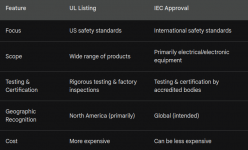ruxton.stanislaw Spammer
Suspended Member
- Location
- Arkansas
- Occupation
- Laboratory Engineer
UL Listing and IEC approval are both important certifications for ensuring product safety, but they have some key differences:
Focus:

Choosing the Right Certification
The choice between UL Listing and IEC approval depends on your target market:
Focus:
- UL Listing: Focuses on meeting the safety standards established by Underwriters Laboratories (UL), a private, not-for-profit organization in the United States. These standards consider factors like fire safety, electrical safety, and mechanical hazards.
- IEC Approval: Focuses on meeting the International Electrotechnical Commission's (IEC) international safety standards. These standards aim to be applicable globally and provide a baseline for product safety.
- UL Listing: UL offers a wider range of listings covering various product categories beyond electrical components. This includes things like building materials, furniture, and personal protective equipment.
- IEC Approval: Primarily focuses on electrical and electronic equipment safety standards.
- UL Listing: Typically involves a more rigorous process including:
- In-depth product testing: Products are tested extensively at UL laboratories to ensure compliance with relevant standards.
- Factory inspections: UL may conduct inspections of manufacturing facilities to verify quality control procedures.
- Regular follow-up audits: Manufacturers with UL listed products are subject to ongoing audits to ensure continued compliance.
- IEC Approval: The approval process can vary depending on the specific standard and certification body involved. However, it generally involves:
- Product testing: Products may be tested by accredited laboratories to relevant IEC standards.
- Certification by a Nationally Recognized Testing Laboratory (NRTL): In many countries, IEC standards are implemented through national certification bodies that can issue IEC certificates.
- UL Listing: Primarily recognized and sought after in North America (US and Canada). While some UL listings might have global acceptance due to mutual recognition agreements, it's not guaranteed.
- IEC Approval: Intended for global recognition. However, individual countries may have additional national safety requirements that need to be met for a product to be sold legally.
- UL Listing: Generally considered more expensive due to the more in-depth testing and certification process.
- IEC Approval: Can vary depending on the specific standard and certification body, but may be less expensive than UL Listing.

Choosing the Right Certification
The choice between UL Listing and IEC approval depends on your target market:
- For products intended for sale in North America: UL Listing is often essential.
- For products intended for global markets: IEC approval is a good starting point, but additional national requirements might exist.

